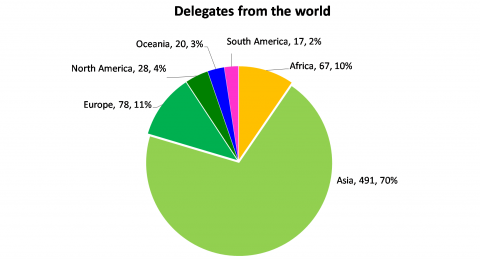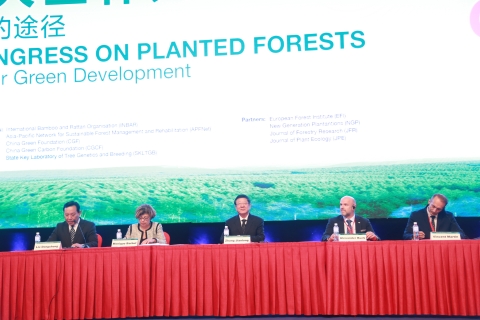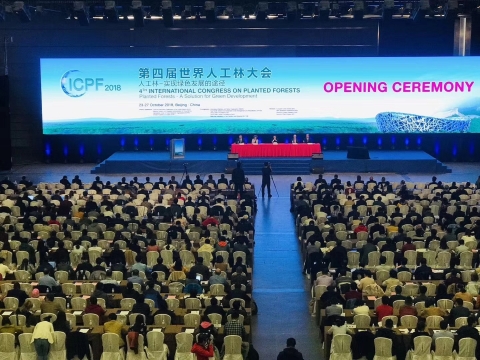Planted forest, a solution for green development: 4th ICPF at a glance

Having previously organised the 3rd edition of the International Congress on Planted Forest, the EFIPLANT unit was actively involved in the preparation of this year’s ICPF (4th International Congress on Planted Forest) edition (Beijing, China, 23-27 October 2018), being part of the organising committee and providing most of the scientific committee from the IUFRO task force planted forest for greener future.
The Chinese forest
A unique afforestation effort
Being hosted in China, this event was a major opportunity to remind that China is the world leading country in plantation areas, to recover from the massive deforestation occurred at the beginning of the 2Oth century dropping the forest areas from 21% to 8.6% in 1949. Facing classical issues induced by the deforestation (soil erosion by wind and water, dust in cities, flooding, wood resource depletion, desertification in the north west, lack of energy and timber...) major afforestation schemes have been launched firstly for restoration and only secondly for wood production purpose, reaching 31 million of plantations in 1986 up to 69 million in 2013 out of the 208 million of forest area. Forest area should reach 23% of the country area in 2018 which is closed from the ultimate target of 26%. Hence, plantation contributed to about 50% of the forest increase in area and volume observed and the mean plantation rate since 1949 is about 2 million ha per year. This history is visible in the species composition, with limited number of genus/species dominating the composition despite very heterogeneous bioclimatic condition with climate, including tropical, subtropical, temperate and temperate boreal climates (from 2000mm of precipitation to 50mm). Only five genus represent 70% of the area and 75% of the growing stock: Chinese fir, poplar, pines, eucalyptus and larch.
Challenges ahead
A forest focusing on protection role
Whatever protective function Is considered -shelterbelt of poplar in agricultural lands, pine and black locust plantations for soil protection in mountains, windbreaks for desertification limitation, casuarina plantation for seaside protection- the time of regeneration has come for the oldest stands and is questioning the means and the techniques needed to maintain the protective role.
In addition, some of the plantations were done with limited genetic resources, sometime using clonal forestry in an appropriate way as on poplar making these stands vulnerable to major outbreaks.
A productivity that can be improved and managed
All these forests having been more often installed with protection purpose than a production one, unappropriated management has been conducted to maximise the growth and timber production. In 2003 estimations of carbon storage were about 26 t/ha showing a major contribution in carbon emission offset of the country, the productivity of Chinese forest is still lower to the world average. This situation leads to a drop in the timber productive forest in 2014 relying mainly on poplar and eucalyptus, resulting in a total discrepancy between timber need of the country (5577 million of m3) and timber production (777 million of m3). Accordingly, major efforts are planned to improve management and wood mobilisation while protecting forest for restoration purpose. About 150,000 students are trained in forestry schools and universities and research organizations every year in China and there is a clear willingness to move toward precision silviculture in China cooperating with all international forest experts to avoid mistakes from the past.
| Types of forest ecosystems | Biomass (t/hm²) | Productivity (t/hm²a) | ||
|---|---|---|---|---|
| Average in China | World average | Average in China | World average | |
|
Tropical forest, monsoon forest |
382.66 | 400 | 18.78 | 19 |
|
Subtropical (temperate evergreen) forest |
364.42 | 350 | 16.11 | 13 |
|
Warm temperate and temperate (deciduous) forest |
253.64 | 300 | 6.89 | 12 |
|
Cold temperate (boreal) forest |
176.12 | 200 | 5.82 | 8 |
ICPF more than a scientific event
With 239 oral presentations and 48 posters given at 55 parallel technical sessions, 2 plenary keynote speeches, 8 sub-plenary invited presentations and 4 special events, the event could attract 701 participants from 70 countries.
This event co-hosted and organized by FAO (Food and Agriculture Organization of the United Nations), NFGA (National Forestry and Grassland Administration) of China, IUFRO (International Union of Forest Research Organizations) and CAF (Chinese Academy of Forestry) addressed the sustainability of planted forests in the context of climate change and the role that can be played by planted forests in the sustainability of biological resources, environment protection and green development. The goals of the Congress were to discover the contribution that have been made and can be made by planted forests to green development under the global change, and to provide scientific support for pursing the sustainable development of planted forests and adapting to and mitigating climate change.
To achieve this, it was made of a combination of scientific talks and keynotes on divers topics such as: modelling and simulators, genomic based breeding, chemical modification of planted wood, genetic conservation, selection for adaptation to climate change, nutrient balance, microbiome role, pest and disease control. Forest management issues have also been discussed with concrete examples on teak, sustainability assessment of plantations, management of degraded stands, multifunctional management, integrated risk management, forest resource monitoring, resilience oriented management, pollution tolerance of planted forests, intensification, design and management of mixed plantations. In addition to these technical presentations many socio economic and management issues, including commercial prospects, have been addressed such as Economic thoughts on Planted Forest Development, added value and bioproducts, chemical use of non-wood forest products. The political dimension was also addressed with presentations on biofuel production, mitigation potential of planted forest, planted forest role in the landscapes, development of circular bioeconomy, policies from improved contribution of planted forest to economies, societies and environment, contribution of planted forest to sustainable wood for a more sustainable world, assessment of the effectiveness of restoration programs, collective reform and rural development
All these presentations of the parallel sessions and special events, were a key opportunity for discussions for a wide range of participants, from forest managers and scientists to policy makers. All abstracts and keynote presentations with contacts and references are available online at www.icpf2018.com
Some key outcomes and take-home messages
Special events have been an opportunity to interact with stakeholders and to collect feedbacks from the participants.
Three special events focused on specific issues of the forestry in China:
- China-CEECs special event on multi-purpose forest management for a greener future-from science to industry
- Special event on co-building the Green Great Wall and sharing development achievements
- Special event: The 40th Anniversary of the Construction of the Three North Program in China -Approaching Beautiful Three North of Green China.
One event was led by the New Generation plantation platform as a World Café to address five specific questions related to planted forests: What findings have emerged from ICPF 2018, and what challenges need further research, on:
- Genetic resources and tree breeding?
- Multipurpose management of planted forests?
- Wood, fibre and non-wood forest products?
- Forest policy, land-use regulation and socio-economics in relation to planted forests?
- What gaps did the conference not cover and need further research?
The results of this survey are available online and include statements related to the following topics:
- How to simultaneously increase productivity in a sustainable manner, and to face the speed at which climate change is affecting the environment?
- How to involve all stakeholders at landscape level to address the multiple purpose management expected on territories?
- How can planted forest satisfies all demands of wood and non-wood products?
- Policies have to address land use competition and land use planning to organise the best valorisation of planted forests
This group also concluded that some topics have not been addressed during the congress on land use, insurance, perception and governance, requiring more advertising of the event to social scientist in the future.
The take-home messages proposed from the conclusive remarks included the following statements:
- Planted forests are increasingly important for both conservation and production purposes globally in the changing environment
- Increasing emphasis will have to be placed on balancing the economic, social and environmental sustainability of planted forests in a broader landscape perspective
- Integrated approaches and models are requirement of sustainable multi-purpose forest management
- There is a need to preserve endangered genetic resources & biodiversity for higher productivity and smart use of planted forests
- Sustainable management and utilization of planted forests for value-added bioproducts are to be developed in a context of an integrated bioeconomy
- Planted forests are vulnerable to both natural and economic hazards, which requires resilience and adaptive capacity
- Long-term monitoring and research on the relationship of productivity and environmental factors should be strengthened, and the contribution of planted forest to trickle climate change should be addressed
ICPF: a brand that will continue in 2023
This unique opportunity to make industries, NGO, practitioners meet scientists and policy makers at a worldwide level was only possible thanks to the strong commitment of the Planted Forest Task Force member Liu Shirong and Wu Shuirong and their team from the Chinese Academy of Forestry who tackled all the logistic challenges induced by such a large event. The feedbacks of the event were so positive that another task force member volunteered to host the next edition of the ICPF2023 in Florida, USA, Tom Fox from the Rayoner company supported by other American colleagues. So get ready to participate in the next session in 2023!
Read here the Summary Report of the 4th International Congress on Planted Forests
More info about the 3rd International Congress on Planted Forest here
Photo credits: Header ©Pascal VU on Flickr






